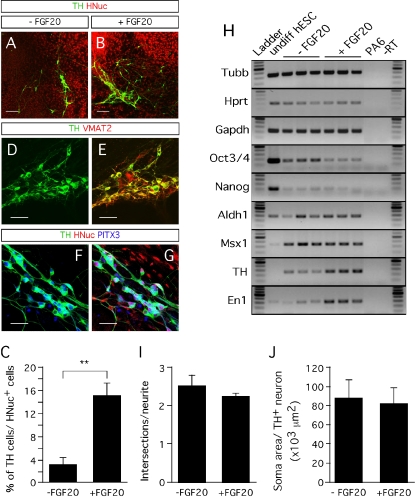Figure 2.
Effect of FGF-20 on dopaminergic differentiation. (A,B) Representative images of TH- and HNuc-positive cells in 3 weeks differentiated hESCs/PA6 co-cultures untreated (A) and treated (B) with FGF-20 (−FGF-20 and +FGF-20, respectively). (C) Graphic representation of the percentages of TH-positive cells among HNuc-positive cells in 3 weeks differentiated hESCs/PA6 co-cultures−FGF-20 and +FGF-20. Average±SEM. Student's t-test, p-value: ** = 0.0012. (D,E) Co-expression of TH and the vesicular monoamine transporter (VMAT) 2. (F,G) Co-expression of TH and the paired-like homeodomain transcription factor 3 (PITX3). (H) RT-PCR analysis of gene expression on undifferentiated hESCs (undiff hESC line); PA6 mouse stromal cells (PA6 line); 3 weeks differentiated hESCs/PA6 co-cultures without FGF-20 (−FGF-20 lines) and with FGF-20 (+FGF-20 lines). Undiff hESCs, undifferentiated human embryonic stem cells; −RT, no polymerase negative control. The three lines falling into both −FGF-20 and +FGF-20 conditions represent the RT-PCR analysis of three separate cultures maintained in the condition indicated. (I) Estimation of the TH-positive neurites length by the number of intersections of the neurites with probe lines in 3 weeks differentiated hESCs/PA6 co-cultures −FGF-20 and +FGF-20. Average±SD. (J) Soma area of TH-positive neurons in 3 weeks differentiated hESCs/PA6 cocultures −FGF-20 and +FGF-20. Average±SD. Distance bars: A, B: 200 μm; D-G: 50 μm.

